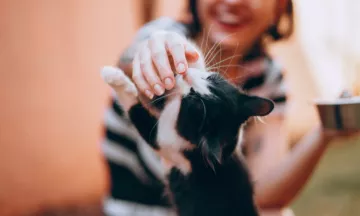Cats and dogs appear to be natural enemies and can sometimes fight like… well, the proverbial cat and dog. They don’t understand each other's body language correctly, which can lead to miscommunication, and 'hunting', squabbling and even aggression as a result. Nevertheless, well-socialised cats and dogs can live together in harmony and ultimately become good friends. Do you wish to home a dog with a resident cat or vice versa? Or are you a pet sitter and want to be able to accommodate other animals in addition to your own cat or dog? Then you must ensure a safe and responsible introduction between your furry companions.
The preperation
Make sure that your dog is nice and tired before introducing him to the cat. Take him out for a long walk beforehand and play fetch with his favourite ball. This will satisfy his chase instinct and generally wear him out, so that he’s in a calm state of mind for the introduction. And make sure that your cat is equally relaxed and happy. Introduce them in the cat’s own home wherever possible: cats typically find new environments stressful and the idea is to make both pets feel comfortable and relaxed. Remember that the house is the cat’s private domain. Make her 'cat corner' housing her litter box forbidden territory for the dog, so that it remains her private realm.
The first whiff of friendship
>Sniffing is an excellent, low-key way of getting your cat and dog used to each other. Don’t introduce the pets at this point, but rather stroke them yourself and subsequently allow them to sniff each other's scent via your hands. This is their first encounter.
Once both pets are in the same home, place them in different rooms so that they are not yet able to see each other, but can explore the space. If that goes well, then swap their rooms to enable them to sniff each other's scent. If this goes satisfactorily, then reward your pets with a favored treat so that they associate the new scent with something positive.

The introduction
Are both pets calm and inquisitive? Then it’s time to introduce them to one another. The safest method is to pop your cat in a kennel or her cat carrier and place this somewhere elevated. Make sure that the cat is familiar with her cat carrier and that she feels comfortable being inside it. Keep the dog on a leash and allow them to observe each other from a distance. If this goes well, then give them both a tasty treat as a reward. You’re now ready to proceed to the next step:
>Keep the dog on a loose leash and allow your cat to go wherever she pleases. Make sure that your cat has several escape routes and elevated points of 'refuge' from which she can safely survey her surroundings. Don’t force the pets to greet each other. Let them determine their own pace. If they remain calm and friendly, then shower them with praise and treat them to a tasty reward.
Body Language
Keep a close eye on both pets’ body language, as this will reveal any brewing irritation or aggression.
If the cat’s ears are pinned back and her tail swishing vigorously, then she’s clearly irritated. If your dog visibly stiffens, points his ears upwards and fixes his gaze on the cat, then he’s undoubtedly in 'hunt' mode. If he licks his lips or yawns, then he’s likely feeling stressed and uncomfortable.
As soon as either pet shows any such signs of aggravation, entice them away with a treat and take them to another room. Try the introduction again at a later moment in time.
Pay attention to your own body language too: are you calm and relaxed or afraid that something might happen? Try to minimize any tension, your own included.
Patience and supervision
Start the introduction slowly by exposing them to one another for a just a few minutes at a time and repeating this daily. If, after a few days, it appears to be going well, then release both pets and allow them to become better acquainted. Some cats and dogs never become friends, others simply take longer (weeks, sometimes months) to learn to tolerate each other. Allow them to take that time, and in the meantime, only allow them together under supervision. Leave them together for a few minutes each day, before setting them apart again. If things don’t improve after a few weeks and the relationship remains dismissive or aggressive, then stop the contact. Give the pets a break or consider engaging a behavioral therapist.
Kittens and puppies
The advantage of introducing kittens and puppies to one another is that young pets don’t yet have a bad experience with the other species. Kittens, in particular, tend to be extremely inquisitive and (still) unafraid of dogs. And many adult dogs are instinctively friendly towards young animals. The danger however of introducing young pets to one another is that they can be slightly brazen. Kittens often don’t realize when a dog wants to chase them and ignore all the warning signals. Puppies tend to engage in rowdy play and can be on the receiving end of an unexpected scratch from a cat who simply wishes to snooze. So, always ensure extra vigilant supervision when introducing kittens and puppies.
Pet sitter
Are you a dog or cat sitter and wish to introduce a cat or dog to your resident pet? Then only do this with a guest pet that is accustomed to other cats or dogs. And always consult with the owner that you wish to introduce their pet to your cat or dog in advance.
The basic rules at a glance:
- Prevent ‘hunting’ behavior
- Reward calm and friendly conduct
- Don’t force the pets to do anything that they don’t want
- Avoid stress and irritation: distract your four-legged friends
- Let the cat determine her own escape route
- Never allow the dog near the cat litter tray
Do you have a sweet dog and cat at your home that are friends with each other? Share your most beautiful and cutest pictures on your Pawshake profile or tag Pawshake on Instagram. And we might soon share your photo with our community!





